Kevin Chen
Defurnishing with X-Ray Vision: Joint Removal of Furniture from Panoramas and Mesh
Jun 06, 2025
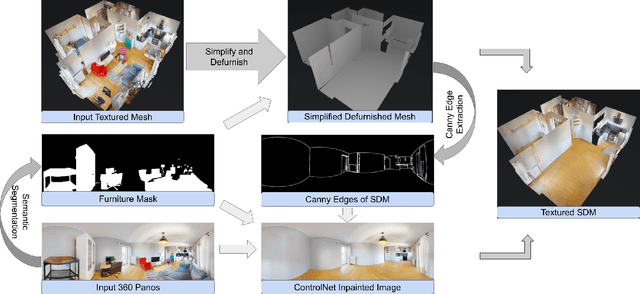

Abstract:We present a pipeline for generating defurnished replicas of indoor spaces represented as textured meshes and corresponding multi-view panoramic images. To achieve this, we first segment and remove furniture from the mesh representation, extend planes, and fill holes, obtaining a simplified defurnished mesh (SDM). This SDM acts as an ``X-ray'' of the scene's underlying structure, guiding the defurnishing process. We extract Canny edges from depth and normal images rendered from the SDM. We then use these as a guide to remove the furniture from panorama images via ControlNet inpainting. This control signal ensures the availability of global geometric information that may be hidden from a particular panoramic view by the furniture being removed. The inpainted panoramas are used to texture the mesh. We show that our approach produces higher quality assets than methods that rely on neural radiance fields, which tend to produce blurry low-resolution images, or RGB-D inpainting, which is highly susceptible to hallucinations.
Reinforcement Learning for Long-Horizon Interactive LLM Agents
Feb 04, 2025Abstract:Interactive digital agents (IDAs) leverage APIs of stateful digital environments to perform tasks in response to user requests. While IDAs powered by instruction-tuned large language models (LLMs) can react to feedback from interface invocations in multi-step exchanges, they have not been trained in their respective digital environments. Prior methods accomplish less than half of tasks in sophisticated benchmarks such as AppWorld. We present a reinforcement learning (RL) approach that trains IDAs directly in their target environments. We formalize this training as a partially observable Markov decision process and derive LOOP, a data- and memory-efficient variant of proximal policy optimization. LOOP uses no value network and maintains exactly one copy of the underlying LLM in memory, making its implementation straightforward and as memory-efficient as fine-tuning a single LLM. A 32-billion-parameter agent trained with LOOP in the AppWorld environment outperforms the much larger OpenAI o1 agent by 9 percentage points (15% relative). To our knowledge, this is the first reported application of RL to IDAs that interact with a stateful, multi-domain, multi-app environment via direct API calls. Our analysis sheds light on the effectiveness of RL in this area, showing that the agent learns to consult the API documentation, avoid unwarranted assumptions, minimize confabulation, and recover from setbacks.
ActiveGAMER: Active GAussian Mapping through Efficient Rendering
Jan 12, 2025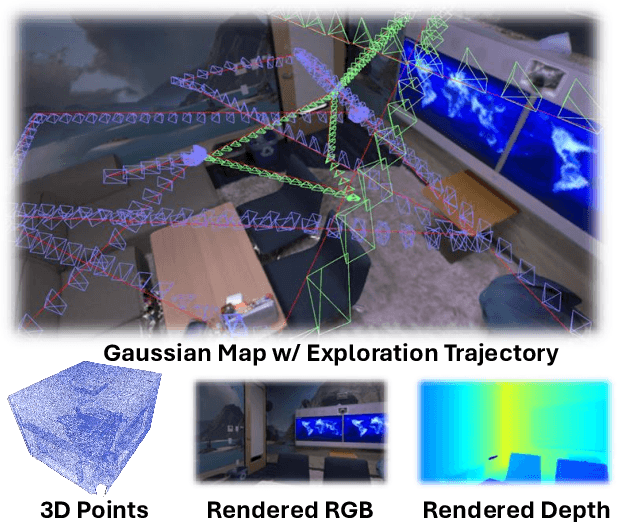
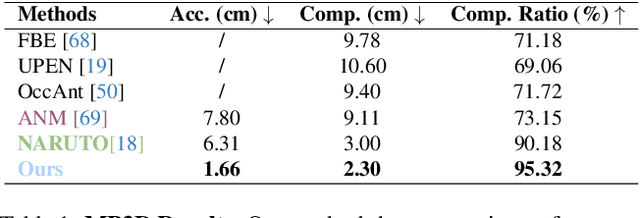

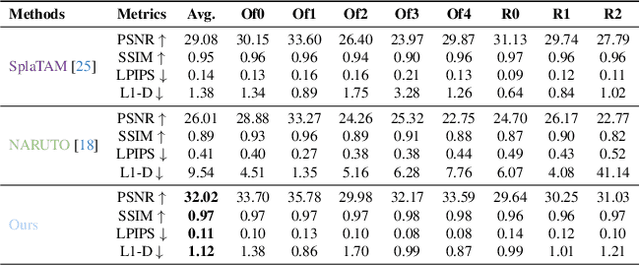
Abstract:We introduce ActiveGAMER, an active mapping system that utilizes 3D Gaussian Splatting (3DGS) to achieve high-quality, real-time scene mapping and exploration. Unlike traditional NeRF-based methods, which are computationally demanding and restrict active mapping performance, our approach leverages the efficient rendering capabilities of 3DGS, allowing effective and efficient exploration in complex environments. The core of our system is a rendering-based information gain module that dynamically identifies the most informative viewpoints for next-best-view planning, enhancing both geometric and photometric reconstruction accuracy. ActiveGAMER also integrates a carefully balanced framework, combining coarse-to-fine exploration, post-refinement, and a global-local keyframe selection strategy to maximize reconstruction completeness and fidelity. Our system autonomously explores and reconstructs environments with state-of-the-art geometric and photometric accuracy and completeness, significantly surpassing existing approaches in both aspects. Extensive evaluations on benchmark datasets such as Replica and MP3D highlight ActiveGAMER's effectiveness in active mapping tasks.
AGGA: A Dataset of Academic Guidelines for Generative AI and Large Language Models
Jan 07, 2025
Abstract:This study introduces AGGA, a dataset comprising 80 academic guidelines for the use of Generative AIs (GAIs) and Large Language Models (LLMs) in academic settings, meticulously collected from official university websites. The dataset contains 188,674 words and serves as a valuable resource for natural language processing tasks commonly applied in requirements engineering, such as model synthesis, abstraction identification, and document structure assessment. Additionally, AGGA can be further annotated to function as a benchmark for various tasks, including ambiguity detection, requirements categorization, and the identification of equivalent requirements. Our methodologically rigorous approach ensured a thorough examination, with a selection of universities that represent a diverse range of global institutions, including top-ranked universities across six continents. The dataset captures perspectives from a variety of academic fields, including humanities, technology, and both public and private institutions, offering a broad spectrum of insights into the integration of GAIs and LLMs in academia.
An Empty Room is All We Want: Automatic Defurnishing of Indoor Panoramas
May 06, 2024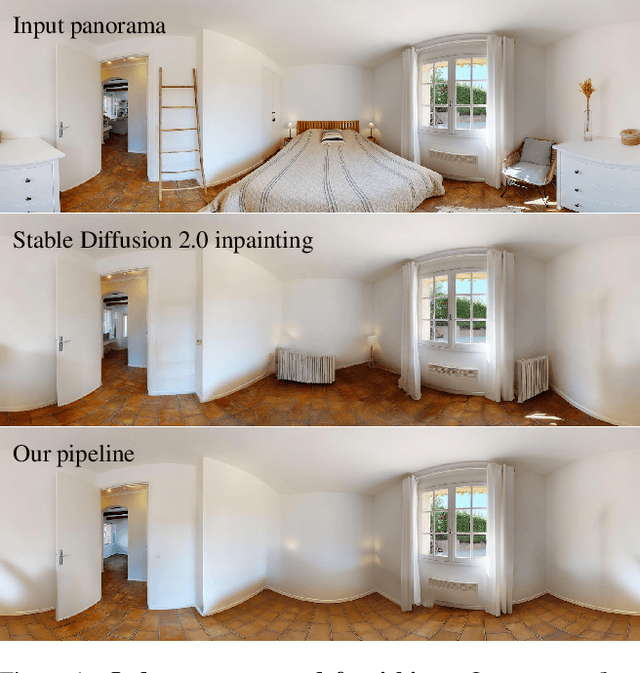
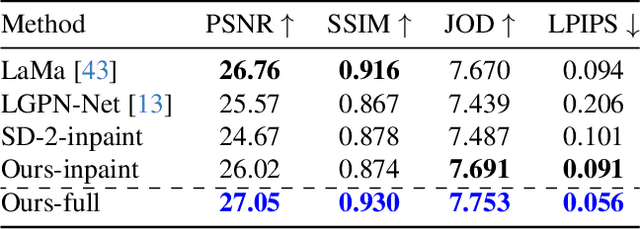
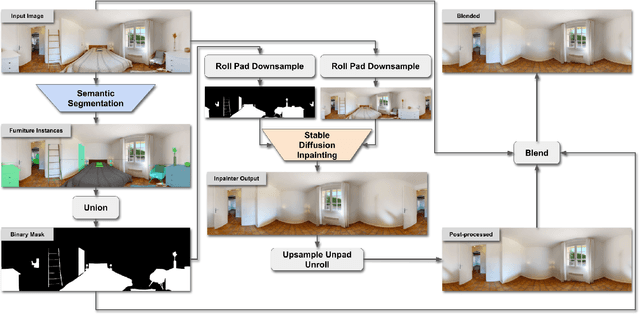

Abstract:We propose a pipeline that leverages Stable Diffusion to improve inpainting results in the context of defurnishing -- the removal of furniture items from indoor panorama images. Specifically, we illustrate how increased context, domain-specific model fine-tuning, and improved image blending can produce high-fidelity inpaints that are geometrically plausible without needing to rely on room layout estimation. We demonstrate qualitative and quantitative improvements over other furniture removal techniques.
Stereo-NEC: Enhancing Stereo Visual-Inertial SLAM Initialization with Normal Epipolar Constraints
Mar 12, 2024



Abstract:We propose an accurate and robust initialization approach for stereo visual-inertial SLAM systems. Unlike the current state-of-the-art method, which heavily relies on the accuracy of a pure visual SLAM system to estimate inertial variables without updating camera poses, potentially compromising accuracy and robustness, our approach offers a different solution. We realize the crucial impact of precise gyroscope bias estimation on rotation accuracy. This, in turn, affects trajectory accuracy due to the accumulation of translation errors. To address this, we first independently estimate the gyroscope bias and use it to formulate a maximum a posteriori problem for further refinement. After this refinement, we proceed to update the rotation estimation by performing IMU integration with gyroscope bias removed from gyroscope measurements. We then leverage robust and accurate rotation estimates to enhance translation estimation via 3-DoF bundle adjustment. Moreover, we introduce a novel approach for determining the success of the initialization by evaluating the residual of the normal epipolar constraint. Extensive evaluations on the EuRoC dataset illustrate that our method excels in accuracy and robustness. It outperforms ORB-SLAM3, the current leading stereo visual-inertial initialization method, in terms of absolute trajectory error and relative rotation error, while maintaining competitive computational speed. Notably, even with 5 keyframes for initialization, our method consistently surpasses the state-of-the-art approach using 10 keyframes in rotation accuracy.
Learning Language-Conditioned Robot Behavior from Offline Data and Crowd-Sourced Annotation
Sep 02, 2021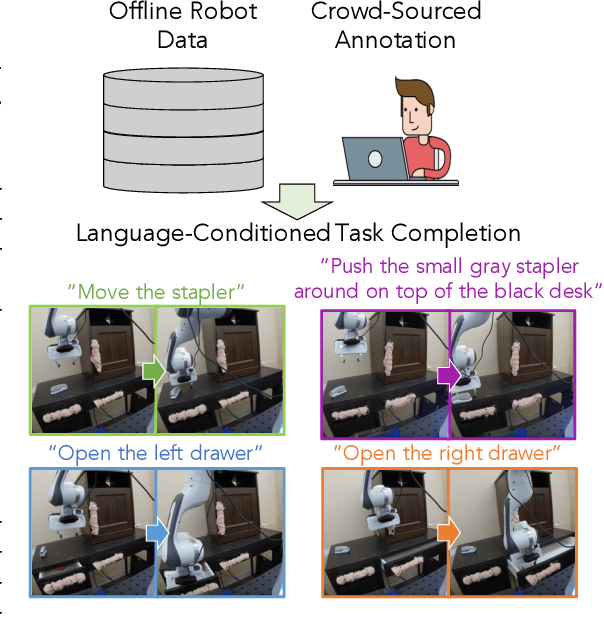
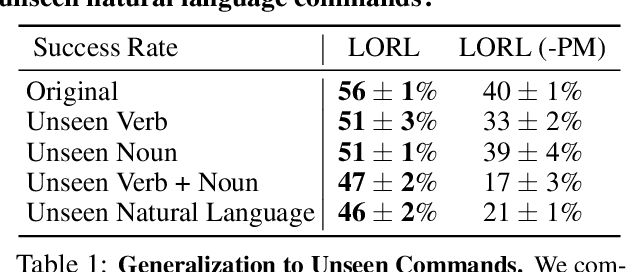
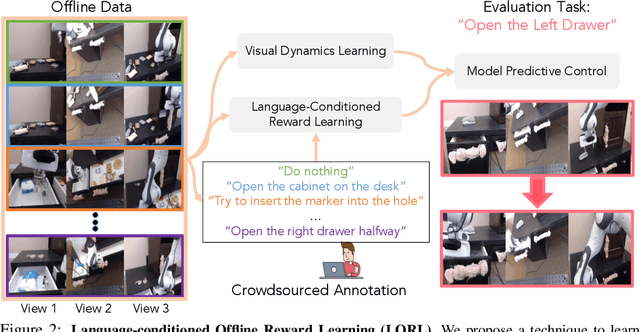
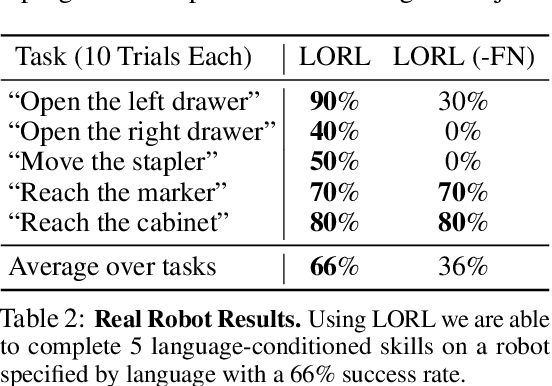
Abstract:We study the problem of learning a range of vision-based manipulation tasks from a large offline dataset of robot interaction. In order to accomplish this, humans need easy and effective ways of specifying tasks to the robot. Goal images are one popular form of task specification, as they are already grounded in the robot's observation space. However, goal images also have a number of drawbacks: they are inconvenient for humans to provide, they can over-specify the desired behavior leading to a sparse reward signal, or under-specify task information in the case of non-goal reaching tasks. Natural language provides a convenient and flexible alternative for task specification, but comes with the challenge of grounding language in the robot's observation space. To scalably learn this grounding we propose to leverage offline robot datasets (including highly sub-optimal, autonomously collected data) with crowd-sourced natural language labels. With this data, we learn a simple classifier which predicts if a change in state completes a language instruction. This provides a language-conditioned reward function that can then be used for offline multi-task RL. In our experiments, we find that on language-conditioned manipulation tasks our approach outperforms both goal-image specifications and language conditioned imitation techniques by more than 25%, and is able to perform visuomotor tasks from natural language, such as "open the right drawer" and "move the stapler", on a Franka Emika Panda robot.
Topological Planning with Transformers for Vision-and-Language Navigation
Dec 09, 2020
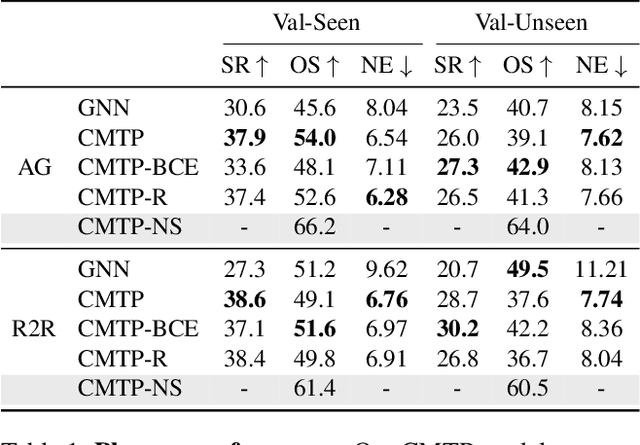


Abstract:Conventional approaches to vision-and-language navigation (VLN) are trained end-to-end but struggle to perform well in freely traversable environments. Inspired by the robotics community, we propose a modular approach to VLN using topological maps. Given a natural language instruction and topological map, our approach leverages attention mechanisms to predict a navigation plan in the map. The plan is then executed with low-level actions (e.g. forward, rotate) using a robust controller. Experiments show that our method outperforms previous end-to-end approaches, generates interpretable navigation plans, and exhibits intelligent behaviors such as backtracking.
Learning Object-conditioned Exploration using Distributed Soft Actor Critic
Jul 30, 2020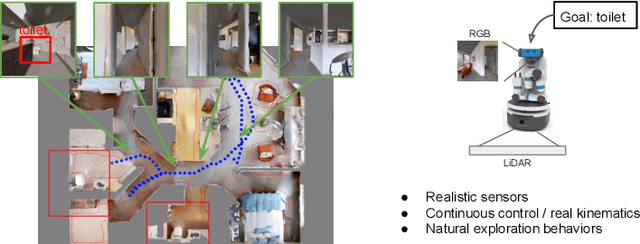
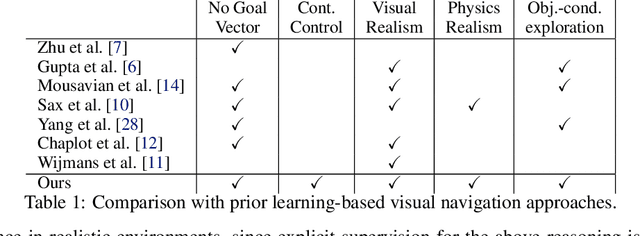
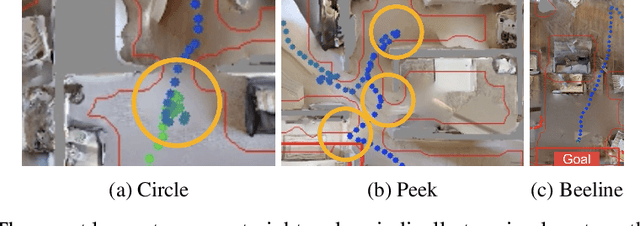

Abstract:Object navigation is defined as navigating to an object of a given label in a complex, unexplored environment. In its general form, this problem poses several challenges for Robotics: semantic exploration of unknown environments in search of an object and low-level control. In this work we study object-guided exploration and low-level control, and present an end-to-end trained navigation policy achieving a success rate of 0.68 and SPL of 0.58 on unseen, visually complex scans of real homes. We propose a highly scalable implementation of an off-policy Reinforcement Learning algorithm, distributed Soft Actor Critic, which allows the system to utilize 98M experience steps in 24 hours on 8 GPUs. Our system learns to control a differential drive mobile base in simulation from a stack of high dimensional observations commonly used on robotic platforms. The learned policy is capable of object-guided exploratory behaviors and low-level control learned from pure experiences in realistic environments.
A Behavioral Approach to Visual Navigation with Graph Localization Networks
Mar 01, 2019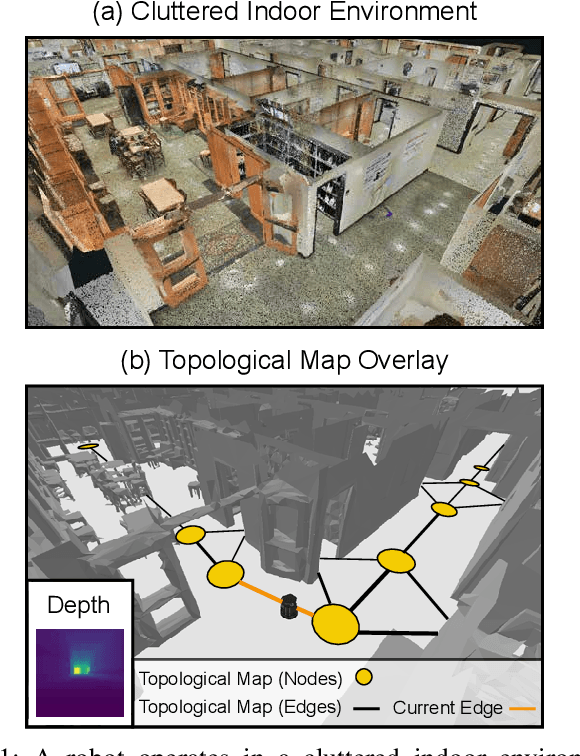
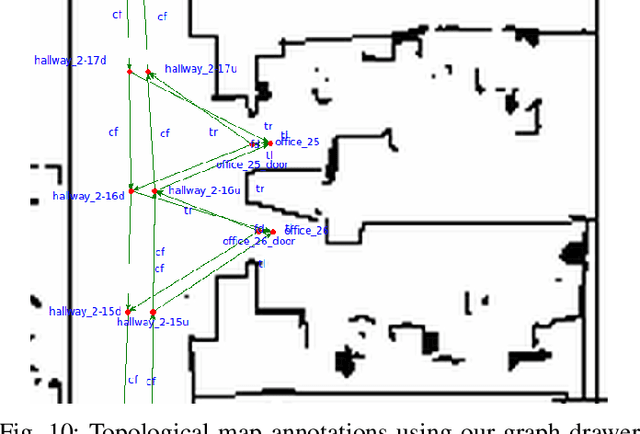


Abstract:Inspired by research in psychology, we introduce a behavioral approach for visual navigation using topological maps. Our goal is to enable a robot to navigate from one location to another, relying only on its visual input and the topological map of the environment. We propose using graph neural networks for localizing the agent in the map, and decompose the action space into primitive behaviors implemented as convolutional or recurrent neural networks. Using the Gibson simulator, we verify that our approach outperforms relevant baselines and is able to navigate in both seen and unseen environments.
 Add to Chrome
Add to Chrome Add to Firefox
Add to Firefox Add to Edge
Add to Edge